Republic of Bulgaria

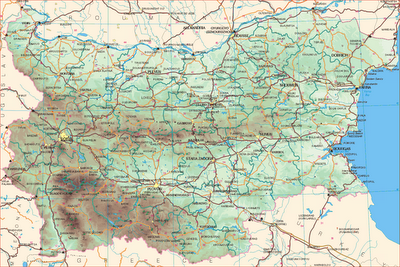
Population: 7.93 million
Capital: Sofia (pop 1.1 million)
Official Language: Bulgarian
Religion: 86% Bulgarian Orthodox, 13% Muslim
Political system: Parliament
RepublicPresident: Georgi Parvanov
Prime Minister: Sergei Stanishev
GDP: US$34.9 billion
GDP per head: US$4300
Annual growth: 5.8%
Inflation: 11.4%

Bulgaria Nature Map

Terrain
Over half of Bulgaria is made up of mountains. The Balkan Mountains separate Bulgaria in two parts. They reach the Black sea to the east and the Bulgarian-Yugoslav border to the north. The plains and the lowlands cover large areas of the both sides of the Balkan Mountains. The Danube plain is the biggest, bordering river Danube to the north and the Balkan Mountains to the south. The southern part of the country has broad and irregular Rhodope Mountains, which form the boundary with Greece. At their western end are the Rila Mountains with Musala, the highest peak on the Balkan Peninsula (2925 m) and the Bulgaria second highest mountain Pirin. The Black sea is the eastern boundary of Bulgaria and its coastline is 378 km. long.
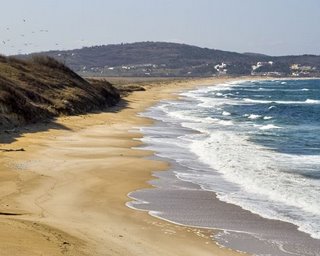



3 March – Liberation Day/Liberation from the Ottoman rule/ - National Holiday of Bulgaria
Easter - Velikden - Sunday and Monday according to the calendar
1 May – Labour Day
6 May – Gergyovden (St. George’s Day), and day of the Bulgarian Army
24 May – Sveti Sveti Kiril i Metodi / St.St. Cyril and Metodius/ - Day of the Cyrillic Alphabet and Bulgarian Education and Culture
6 September - Unification Day – unification of Bulgaria and Eastern Rumelia
22 September – Independence Day /Independence from the Ottoman Empire/
24,25,26 December – Koleda - Christmas Days
If you intend to travel by car around Bulgaria keep in mind the vignette system, valid since this year for the national road network, except for the roads within populated areas. You can buy a vignette from all border-crossing points, all post offices and most gas stations. The prices of vignettes are in EUR and USD. They are different depending on the type of the vehicle and the time period.

1. Those issued by the states that have signed the Vienna Convention
2. Certified translation of the driving license.
3. International driving license.
The minimum age for driving is 18 years. Traffic drives on the right. Speed limits are 120kph (75mph) on motorways, 90kph (56mph) on country roads and 50kph (31mph) in urban areas. You are obliged to use safety seat belts no matter where you sit in the car both inside and outside populated areas. Talking on a cellular telephone while driving is not allowed, unless you use a hands-free device. Drinking and driving is strictly forbidden.
The police often stop the motorists to check their documents: registration and ownership documents of the vehicle or a certified letter of attorney by the owner; international motor insurance /Green Card/ and passport. Do not get out of the car and wait for the policeman to approach, remain calm and polite.
Note: in case of breaking of traffic rules you are not obliged pay a fine on spot. The police can only impose a sanction by drawing up a statement. The due amount you have to pay at the customs when leaving the country. All accidents must be reported to the traffic police /KAT/ and a report be filed. The process is lengthy but necessary for any insurance claims.

Ambulance - 150
Fire - 160
Road Assistance Service – 91146 and 146
/inside Bulgarian mobile networks/
Lev (BGL). BGL1=100 Stotinki
Notes: BGL1, 2, 5, 10, 20, 50 and 100
Coins: Stotinki 1, 2, 5, 10, 20 and 50, BGL1

The Bulgarian lev is pegged to the Euro at rate 1 EUR = 1.956 BGL. Against the other currencies there are minor fluctuations depending on their varying exchange rates towards the Euro.
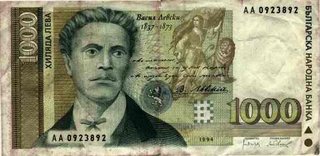
The most typical characteristics of the Bulgarian language are elimination of noun declension, suffixed definite article, lack of a verb infinitive and complicated verb system - there are various verb forms to express nonwitnessed, retold, and doubtful action. The words in Bulgarian are pronounced in the same way in which they are written. Problematic is the transcription of the Bulgarian names in Latin alphabet because the different phonetic codes in English, French and German.
The Bulgarians’ names consist of three parts - personal, father’s and family name. It is important to know that the suffixes of the women’s father or family names always change by adding „a” after the last consonant!

By plane
In Bulgaria there are three international airports: Sofia, Varna and Bourgas. The Bulgarian air companies have flights to the most European countries as well as all major European air lines have regular flights to Bulgaria. While flights to Sofia are normally priced, there are a lot of charter cheap flights to Bulgaria offered to Varna and Bourgas leaving from Western Europe especially in the summer tourist season.
By train
The main European railway routes pass through Bulgaria. Sofia has direct links with many European capital cities. Probably it is the cheapest way to reach Bulgaria.
By bus
Buses to and from Sofia travel to most major cities in Europe. Most of them pass through Serbia, so be sure to check if you need a transit visa. Don't be surprised if an extra "border fee" is asked by the bus driver - it makes your border passing quicker.
By car
If you want to reach Bulgaria from Western Europe by car, you either can take a ferry from Italy to Greece, or you will have to pass through either Serbia where you have to pay a special car insurance just passing through, or Romania where the road conditions are far from perfect. Foreign driving licenses are valid in Bulgaria. Insurance is compulsory - it can either be taken out beforehand or on the Bulgarian border. The speed limit in the country is 60 km/h in populated areas, 80 km/h outside and 120 km/h on highways. You must place a special sticker on your car to drive on the highways. These stickers can be purchased at the gas stations. You can be enter Bulgaria through the following border checkpoints:

Kalotina (motorway E-6)
Vrushka Chouka (Belgrad- Kulata-Sofia motorway)
Bulgarian - Macedonian border
Gyueshevo (Sofia, Kyustendil-Skopje motorway)
Bulgarian-Greek border
Kulata (motorway E-20)
Novo Selo (E80)
Bulgarian-Turkish border
Kapitan Andreevo (motorway E-5)
Malko Turnovo (motorway E-95)
Bulgarian-Romanian border
Rousse (motorway E-97)
Vidin-Calafat
Vranshka Chuka-Kula (motorway 14)
Silistra (motorway)
The Bulgarian lands have been inhabited by various tribes that have developed a rich and varied culture.
The earliest monuments are the drawings found in the Magura cave (Second Millennium BC), the remains from Palaeolitic cultures in several caves in Stara planina (Balkan Mountains) and the Rhodope Mountains. Traces of some seaside Neolithic and Palaeolithic cultures have been found in the areas of cape Kaliakra and the southern seaside town Ahtopol.
There have been found a lot of remains from Thracian, Old Greek and Roman culture in the Bulgarian lands. The Kazanluk tomb and the Sveshtare tomb are remarkable monuments of the Thracian art. The Kazanluk tomb is from the end of the 4th and the beginning of the 3rd century BC. The murals on the walls of the tomb reflect battle scenes and the symbolic farewell with the Thracian ruler accompanied by three racing chariots. The Sveshtare tomb is built in the first half of the 3rd century BC. The chamber was decorated as a facade of a temple with depicted horseman who takes a golden garland from the hands of a goddess with a religious procession following her.
Whole ancient cities have been restored. Some of them are Augusta Trajana, Apolonia, Trimoncium, Nicopolis ad Istrum etc. Under the capital city Sofia have been found thousands square meters of ruins from the ancient city Serdica.
In the Middle Ages massive fortifications, monumental castles, temples and basilicas are built in the Old Bulgarian capitals Pliska and Veliki Preslav.
After the 14th century the more remarkable manifestations of architecture and the arts are of religious character. The most impressive architectural creation is the Rila Monastery.

The Eastern Orthodox Church emerged as a result of disagreements between Greek speaking eastern churches and Latin speaking western churches over doctrine and ecclesiastical authority. During the Ottoman rule it was placed under the jurisdiction of the patriarch of Constantinople. However, with the demise of the Ottoman empire many independent churches emerged in eastern Europe. Remaining in communion they retain their independence.
The Bulgarian Orthodox Church as an autocephalous Eastern Orthodox Church was established in 865 when Boris I was baptised by Greek missionaries. In the centuries of Ottoman yoke it was the only link with other Eastern Orthodox peoples and with European Christianity in the resistance to the Islamic invasion. It became independent in 1870 by a decree of the sultan and thus won the international juridical recognition of the Bulgarian nation before its political one.
During the communist era the church's property was confiscated by the state. The constitution of 1991 guaranteed freedom of religion while recognising Eastern Orthodoxy as "the traditional religion in Bulgaria". 88.5% of the population of Bulgaria belong to the Bulgarian Orthodox Church.
The Bulgarian Orthodox Church has an extremely rich history of icons which depict Biblical scenes, local saints, the Virgin Mary or Jesus. The icon is of particular importance for the Orthodox Church since it is seen as the dwelling place of God's grace, creating in the faithful a sense of the presence of God. Thanks to this, even now Bulgarian artists continue to create icons with the clear sense, that they are an example of an exclusive spiritual and artistic phenomenon. The presence of the icon in our life helps us to overcome the psychological barriers of our material world.
The Bulgarian Orthodox Church is an autocephalous Eastern Orthodox Church with some 6.5 million members in the Republic of Bulgaria and between 1.5 and 2.0 million members in a number of European countries, the Americas and Australia. The recognition of the autocephalous Bulgarian Patriarchate by the Patriarchate of Constantinople in 927 AD makes the Bulgarian Orthodox Church the oldest autocephalous Slavic Orthodox Church in the world, which was added to the Pentarchy of the original Patriarchates - those of Rome (which subsequently split off to grow into today's Roman Catholic Church), Constantinople, Alexandria, Antioch and Jerusalem - and the autocephalous Georgian Catholicosate.

The Bulgarian monasteries - hiding human, warm and living rather than "divine" beauty behind their austere stone facades, still amaze with their magnificent architecture, unfading frescoes and murals, exquisite icons and wood-carvings, made by self-taught architects, builders and painters.
The Bulgarian monasteries - during difficult and turbulent times they acted as centers of patriotism which helped to preserve national feelings and hopes of the Bulgarians.
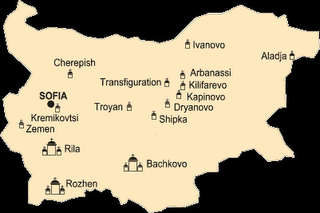
The soft radiance of the Bulgarian icon is a grand dimension of the fate, stability and spiritual evolution of the Bulgarians after their conversion to Christianity during the 9th century. Nameless master painters filled the dead iconographic scheme with life, exquisiteness and bursts of colour. The canonical ascetic faces were replaced by youthful looking saints, humble hermit, venerable prophets and lifelike portraits of the Blessed Virgin. Their deep-set eyes radiate wisdom and a love of mankind. The virtuoso line and the vivid, exuberant colour imposed a new ideal of beauty, previously unknown in the Christian world.
The tradition of the Bulgarian icon was enriched throughout its millennial history before attaining its zenith during the National Revival period (17th-19th century). The time was ripe for the manifestation of the great artistic taste and talent of the Bulgarian. Whole families of gifted artists brought fame to the three icon-painting schools of Troyan, Samokov and Bansko. Their art works adorned not only the newly built churches, they also entered the Bulgarian home. This explains why icons are so dear to the Bulgarian heart.
The most valuable examples of our icon-painting heritage today are displayed in the Crypt of the Alexander Nevsky Memorial Cathedral and the National Museum of Church History and Archaeology in Sofia, the Museum of History of Art in Varna and the Museum of Wood-carving and Painting in Tryavna. A considerable part is kept in the altars of churches and monasteries throughout the country.
![]()
Because of its geographical position and long history Bulgarian cuisine is a mixture between the Slavonic, Greek and Turkish cuisines. The basic food products used in the Bulgarian cuisine are beans, milk, yogurt, cheese, tomatoes, potatoes, apples, water-melons, grapes, etc. Bulgarians eat also pork, beef, lamb, chicken and fish. National specialties include: Shopska salad (sliced tomatoes, cucumbers, peppers and parsley topped with grated sheep's cheese); and tarator (a cold soup of chopped cucumber, walnuts and yogurt). White sheep's cheese baked with eggs is another favorite. Other typical items on the menu include kavarma (individual casseroles of pork or veal, onions and mushrooms), shishkebab, stuffed vine or cabbage leaves and moussaka. Yogurt too, tastes better in Bulgaria, its country of origin. Other Bulgarian specialty is banitza (pasty).
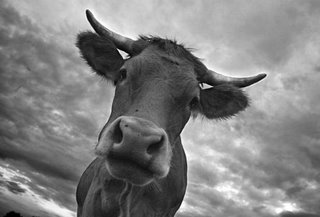
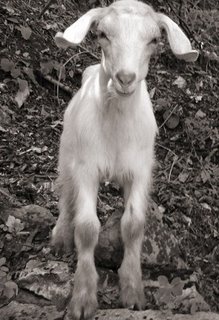
BULGARIAN WINES are the perfect companion for Bulgarian food. The choice is wide. However, you can tell the best wine by their controlled Label of origin guaranteeing that they have been made from special varieties of grapes grown in specific localities. The modern history of the Bulgarian wines begins in the early 1900s when a generation of young wine-growers graduated in France and started the modern growing of grapes. In 1970s Bulgarian wines like Chardonnay, Cabernet and Merlot appeared in the European markets and are still very popular in Great Britain, Belgium, the Netherlands, Luxembourg, Germany, Scandinavian countries. Original local red grapes Mavrud and Melnik are grown in Bulgaria and are very interesting to the wine connoisseurs. Beer is also very popular in Bulgaria.

The most popular sport in Bulgaria is football (soccer). Bulgaria's greatest success in this field is the fourth place in the 1994 World Football Championship held in the US with the participation of the well known players Hristo Stoichkov, Trifon Ivanov, Yordan Lechkov, Krassimir Balukov etc. But the most popular in Bulgaria is Hristo Stoichkov, who earned world fame during the several seasons he spent in Spain's team of Barcelona, and now he is a coach of National football team of Bulgaria. Lately became famous also Dimitar Berbatov who plays for Bayer Leverkusen since 2001 and the young but very successful Valeri Bojinov – player of Fiorentina. Bulgaria is also good at the art gymnastics – a very popular sport among the Bulgarian girls. The list of World and European titles is very long. Bulgaria has remarkable athletes such as the charming Ivet Lalova and Stefka Kostadinova – the high jump world record-holder. Bulgaria has great achievements in the weight lifting, wrestling and boxing. World famous are also the tennis player Maleevi sisters and the 15-years old very prospective Sessil Karatancheva.

During the Turkish domination (1396-1878) Bulgarian literature virtually ceased to exist. The 19th century marked The Revival in the history of Bulgaria including the literature. It had its origin still in 1762 in the works of the monk Piasii Hilendarski “History of the Slavic-Bulgarians”. Later began the establishment of Bulgarian schools, publication of Bulgarian grammars and other educational works, that played a great part in developing of a new Bulgarian literature.
Most Bulgarian writers in this period were concerned with social and political problems and mainly the struggle for national independence. Among the best known are Hristo Botev and Ivan Vazov. Other important writers of this period were Stoyan Mikhaylovski, Dobri Voinikov, Lyuben Karavelov, Zahari Stoyanov, Aleko Konstantinov.
In the post-liberation period, the Bulgarian writers increasingly began to emphasize on the form, style and harmony of the language. Important writers of this period are the short-story writers Elin Pelin and Yordan Yovkov; the poets Peyo Yavorov, Kiril Hristov and many others.
The Bulgarian literature after 1940 is strong impacted by the Soviet socialist literature but despite this influence it certainly must be mentioned the remarkable novelists Dimitar Dimov and Dimitar Talev. <>br/>Modern authors include Yordan Radichkov, Nikolai Haitov, Nedyalko Yordanov, Viktor Paskov etc.
The Bulgaria-EU accession talks were initiated in the beginning of 2000 as the Government has set up an ambitious agenda to complete them by 2006. The main components of the reform program continue to be fast and transparent privatisation and restructuring of the state-owned enterprises, the financial and banking sector reform, the liberalization of agricultural and energy sectors, the adoption of the health insurance system, the pension system reform, and the administrative reforms in the public sector.
Chemical industry is a leading sector in Bulgarian industry. It provides a number of intermediary and final products for the domestic and export markets such as fertilizers, soda, plastics, PVC, polyamide and polyester fibers, paints, detergents, pharmaceuticals and cosmetics. They have a substantial share of Bulgarian export. Products of tobacco and food industry in Bulgaria accounted for 19.% of total industrial output, with an export share of 16.7 %. Tourism is the fastest growing sector in the Bulgarian economy with excellent opportunities for foreign investment with high return on investment ratios. Other sectors having strategic position in the Bulgarian economy are mechanical and electrical engineering, ferrous and non-ferrous metallurgy,electronics industry and telecommunications.
On April 25th, 2005 it was signed the Bulgaria-EU Accession Treaty and is set Bulgaria to join the EU in 2007.
Dobrich
Gabrovo
Haskovo
Kardzhali
Kyustendil Lovech
Montana
Pazardzhik
Pernik
Pleven
Plovdiv
Razgrad Ruse
Shumen
Silistra
Sliven
Smolyan
Sofia
Sofia Province Stara Zagora
Targovishte
Varna
Veliko Tarnovo
Vidin
Vratsa

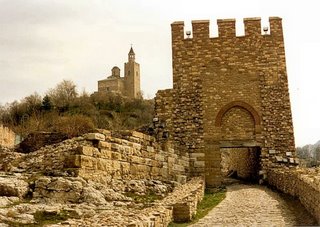 Pictorial Art
Pictorial ArtModern Bulgarian art conveys the artist's conception of the world, tries to capture his elusive thought and communicate his feelings, making it innovating and expressive. The inspired Madonnas of Vladimir Dimitrov - The Master, the gentle watercolors of K. Shturelkov, the poetry of N.Petrov, the fantastic images of S. Seferov, the blazing colors of G. Genkov, the fine drawings of B. Angelushev, forms of A.Dalchev and V.Rashidov, are only a small part of the national wealth.
You will find galleries in almost all Bulgarian towns and cities - large and small, state-owned and private ones-displaying the achievements of Bulgaria's creative artists.The richest collection are kept in: the National Art Gallery in Sofia which traces the development of Bulgarian art from its classical forms until today's modern visual means; the Sofia City Gallery which popularizes the work of the many different masters of fine art; the Art Gallery of the St. St. Cyril and Methodius Foundation where works from all the world are exibited.

http://www.centralbalkannationalpark.org/en/
Sands National Park
Pirin National Park: http://www.pirin-np.com/English/pirin-np_E.htm
Rhodope National Park
http://www.rhodope.net/
Rila National Park
http://www.rilanationalpark.org/en/
Lom National Park
Kamani National Park
Plateau National Park
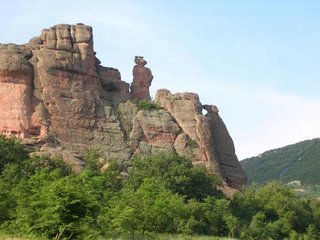
Stara Planina (Balkan Mountains)
http://www.staraplanina.org/index.php
Strandja National Park
http://www.discoverstrandja.com/index.php
Vitosha National Park
http://www.picturesofbulgaria.com/article/vitosha_national_park.html
Balkan National Park

This is the Slavic name the Proto-Bulgarians gave to the first capital of their new state.
Reviving the traditions of their predecessors they erected a monumental and austere looking city.
Remains of the most impressive buildings have survived until the present: the Large Basilica, the palaces and Throne Room from the second half of the 9-th century.
Pliska is now a National Archaeological Reserve.
Built over nearly three decades by Tsar Simeon, the second Bulgarian capital was designed to correspond to the prosperity and upsurge of the Bulgarian state, the conversion to Christianity, the creation of the Slav script and culture.
As in Pliska, two fortress walls surrounded the city here too.
With its splendour and ornate decorations the inner city, housing the palace complex and the famous Golden Church, demonstrated the power and confidence of the Bulgarian rulers.
The nearby PATLEINA MONASTERY, part of the Veliki Preslav National Archaeological Reserve, was a center of writers of the famous Preslav school of literature and the place where the unique painted 'Preslav ceramics' were crafted.

The capital of the Second Bulgarian Empire ( 1185 - 1393).
If you should happen to visit this unusual city whose stone houses seem perched one above the other on the steep bank of the Yatra river, you will first be taken to see Tsarevets - the place of the patriarchal church and royal palaces, the hill where Baudouin's Tower still rises, linked with the legend of the Latin Emperor Baudouin of Flanders who was captured by Tsar Kaloyan.
Then you will be shown another hill Trapezitsa - where the foundations of 17 mediaeval churches were discovered.
You will marvel and enthuse over the Bulgarian National Revival period architectural ensembles on Gurko Street, the old Nikoli Inn and the St. St. Constantine and Helena Church.
The original SAMOVODENE MARKET has been brought , back to life and, as in olden times, skillful craftsmen fashion and sell exquisite objects in the small restored workshops.
At night, proud Tsarevets lends the natural decor to a fantastic SOUND AND LIGHT spectacle.

Melodious tunes and beautiful voices, fiery dances and brightly coloured costumes - Bulgarian folklore has to be seen, felt and experienced!
The world has already discovered Ninth Symphony, its message to other civilizations travelling to the stars aboard the Voyager I and Voyager 2 spaceships also includes the recording of a Bulgarian Rhodope Mountain folk song.
The world is discovering it again and again at major folklore and song contests in Italy, France, England and Ireland from which the Bulgarian music and dance ensembles invariably walk off with the first prizes.
The world has started talking about the "Mystery of Bulgarian songs and dances"...
If you attend one of the many picturesque folk fairs, singing contests and original folklore festivals in this Country, which gather thousands of singers, musicians and dancers, where several generations of Bulgarians sing, play and dance, you will perhaps yourself discover the key to this mystery, the key to the heart and soul of Bulgaria.


For those keen on this type of tourism Bulgaria has long since stopped being a blank spot on the world's hunting map.
The country's hunting grounds are populated by red deer, Sika deer, roe deer, wild boars, bears, mouflons, wild goats, rabbits, capercaillies, pheasants, partridges, quails and wild ducks.
Deer hunts are most attractive to connoisseurs for they know that Bulgaria is unrivalled both with regard to the quality of trophies and the standard of hunting organization.
Hunting Lodge This is evidenced by the fact that seven of the world's ten finest trophies are Bulgarian.
Foreign hunters are accommodated in first class hotels or hunting lodges and ensured a full range of specific hunting services: interpreters, guides and beaters, special vehicles, microbuses and jeeps, hounds and trophy valuers.
The only restriction is observance of the hunting season.

The Bulgarian's aesthetic sense and conception of the world makes him create art out of any material - wood and clay, wool and copper, silk and silver.
Applied crafts have gradually emerged from the narrow frame work of strictly domestic life to become an art which breeds art: Bulgarian embroidery with its intricate geometrical figures, Bulgarian rugs and carpets with their vibrant colours, exquisitely painted Bulgarian ceramics, finely ornamented Bulgarian fretwork and superbly fashioned Bulgarian jewelry.
The Samovodene Market in Veliko Turnovo, the Permanent National Exhibition of Folk Art in Oreshak near Troyan and the Etura architectural and ethnographic complex near Gabrovo are all original museums of the revived beauty of Bulgarian handicrafts. You are bound to find your own particular memento from Bulgaria here - a small carved wooden wine vessel, a Troyan pottery set, a fleecy Rhodope rug, an original piece of silver jewelry, a finely embroidered silk blouse of a colourful carpet.
Or you might just choose a phial of attar of roses with the intoxicating fragrance of the whole Valley of Roses.
http://www.horseridingbulgaria.com/site/files/riding_bases_rose_valley.jpg

Festivals and CustomsFull of beauty, gaiety and a healthy love of life, the Bulgarian festivals and customs date back to ancient times when mail tried to appease the natural elements and trembled before their power. One of the merriest and richest festivals in a ritual aspect are Christmas and the New Year, when the so called 'sourvakari' make the round of houses with wishes for health and prosperity. Other major festivals include "ladouvane" - a festive ritual for young girls on New Year's Day or Midsummer Day (24 June), Shrovetide and Mummers' Games which take their beginnings from the Dionysian festivals of the Thracians and mark the start of spring, 'lazarouvane' - an Orthodox festival dedicated to love and the family, Trifon Zarezan (Vinegrower's Day) and St. George's Day, linked with health and abundance. And among them, the widely popular and typically Bulgarian customs and festivals - 'martenitsas' and rose-picking.

Millennia after, their ancient and mysterious culture was revealed in its true magnificence.
The unearthed Thracian gold treasures conquered the modern world and enabled a great civilization to take its deserving place in the history of mankind.
The Varna Chalcolithic Necropolis (4600 - 4200 B.C.) which experts qualify as 'the world's oldest gold and Europe's most ancient civilization' was a sensational discovery. The 28 objects - bracelets, hatches, ornaments, are now kept in the Varna Museum of History. The Vulchitrun treasure dates from the Bronze Age. The perfectly shaped and carefully polished ritual vessels weight 12.5 kg. They are part of the exhibition of the National Museum of History.
The Panagyuriste gold treasure (4th c.B.C.) is a royal set made of 23 carat gold. The nine exquisitely shaped vessels - rhytons, amphoras and a phial - are embossed and depict mythological scenes. It is kept in the Plovdiv Museum.
The Vratsa treasure (4th c.B.C) consists of a number of beautiful objects - a golden wreath, earrings and graves.
The Loukovit and Letnitsa treasures (4th c.B.C.) are both interesting and valuable.
The Rogozen royal silver treasure attracts attention with its 165 vessels with Greek and Thracian subjects.
These treasures are necessary to us today because their brilliance and beauty invariably return us to man's longing for harmony.



0 Comments:
Post a Comment
<< Home